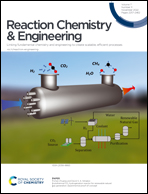The Al(iii)-based polydentate chelate complex catalyzed cycloaddition of carbon dioxide and epoxides: synthetic optimization and mechanistic study†
Abstract
Aimed at greenhouse gas CO2 high value-added utilization, a N,N′-(propane-1,3-diyl)dipicolinamide (PPPA) supported Al(III) metal–organic polydentate chelate complex (Al-PPPA) was designed and used to efficiently catalyze CO2 to cyclic carbonates. The substrate conversion and product selectivity were more than 95% and 98%, respectively, at 120 °C and 2 MPa CO2 without the presence of a co-catalyst. After 5 times of recycling, the substrate conversion was no less than 88%, which indicated the excellent thermal stability and reusability of the catalyst. Simultaneously, the catalyst showed a widely universal range of substrates including olefin chains, phenyl chains, internal epoxides and fluorine-containing epoxides. Furthermore, the plausible mechanism of the CO2 cycloaddition reaction was explored by employing in situ IR technology. The ring opening of PO, CO2 activation and the formation of the final products were examined visually. This work supplies a new route for the theoretical and experimental exploration of new catalyst design and process understanding for efficient greenhouse gas reuse.



 Please wait while we load your content...
Please wait while we load your content...